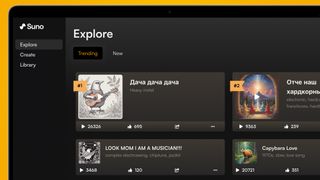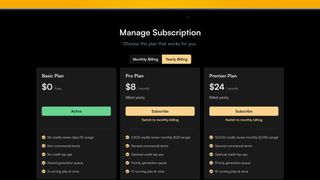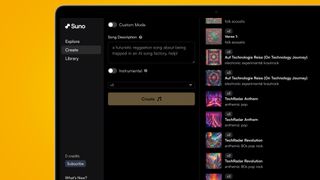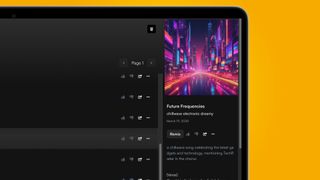What is Suno? The viral AI song generator explained – and how to use it for free
Since ChatGPT burst onto the scene in November 2022 we’ve seen generative AI make some some startlingly human-like artistic creations – and the latest tool to go viral is Suno, an AI-powered song generator.
We’ve seen AI music generators before, from Adobe’s Project Music GenAI to YouTube’s Dream Track and Voicify AI (now Jammable). But the difference with Suno is that it can create everything, from song lyrics to vocals and instrumentation, from a simple prompt. You can even steer it towards the precise genre you want, from Delta Blues to electronic chillwave.
In Suno’s new V3 model, you can now create full two-minute songs with a free account. The results can be varied, depending on which genre you choose, but Suno is capable of some seriously impressive results.
But how exactly does Suno work, who actually owns the rights to its generated music, and how can you start making your own robo-rock? We’ve answered all of this and more so you can stage-dive into the strange world of AI-generated music…
What is Suno?
Suno is a web-based, text-to-music generator that can whip up full songs in seconds from a simple text prompt. For example, tell it to make a ‘psychedelic UK garage song about a friend with a Nokia obsession’, and you’ll get a couple of two-minute songs complete with vocals, instrumentation, lyrics, a song title and even artwork.
This is all possible with the free version of Suno, although those accounts naturally come with limitations. You get a maximum of 50 credits per day, which is enough for ten songs. You also can’t use the songs commercially with a free account, so it’s very much for dabbling and or writing songs for your dog.
Shell out for the Pro plan ($8 a month, around £6.30 / AU$12.20) and you get enough credits to generate 500 songs a day. You can also use the songs commercially, for example on YouTube or even uploading them to Spotify or Apple Music.
The Premier Plan ($24 a month, around £20 / AU$38) bumps your limit up to 2,000 songs a day, which makes Bob Dylan look positively lazy. But whichever plan you’re on, you get access to all of Suno’s tools – including a ‘custom’ mode where you write your own lyrics and an ‘instrumental’ mode for crafting some new work music.
How does Suno work?
Like most generative AI tools, the precise mechanics of how Suno works are a little hazy. It isn’t yet clear what data or music the tool has been trained on – we asked Suno for clarification on this and are yet to hear back.
But more broadly, Suno works in a similar way to large language models (LLMs) like ChatGPT. Lots of training data (which in Suno’s case, includes recordings of speech) help it construct original songs and lyrics based on your prompts. With text, LLMs typically work by predicting what words are most likely to come next in a given sequence, but this is far more challenging for music.
This is why Suno also uses so-called diffusion models (which power the likes of Midjourney) alongside transformer models. In an interview with Lightspeed Venture Partners Suno’s CEO and Co-Founder, Mikey Shulman, said: “Not all audio is done with transformers, there’s a lot of audio that’s done with diffusion – and these two methods have pros and cons”.
Whatever the algorithmic rumblings that are going on under Suno’s hood, it’s one of the best AI music generating engines we’ve seen (or heard) so far. Sure, the results are heavily compressed and it’s stronger at aping some genres than others, but it’s also the perfect project for a rainy weekend afternoon…
How do you use Suno?
Suno is ridiculously easy to use – perhaps worryingly so, if you currently make your money from music. Just go to the Suno website, make a free account and head to the ‘Create’ section to get started.
Here you’ll find a small box to write the description for your song. The main thing to remember is to describe the style of the music you want (in other words, the genre) plus the topic you want the song to be about. You can’t ask Suno to write something in the style of a particular artist – which is understandable, as Suno doesn’t (yet) have any licenses with labels.
We asked Suno to write a TechRadar theme song celebrating gadgets and technology in the genre of electronic chillwave – you can listen to the resulting ‘Future frequencies’ song below (or by opening the song on Suno, where you can also read its lyrics).
Not bad for a first try. It won’t win any Grammys, with its generic EDM synth sound and echoes of The Weeknd, but it’s also one of the few times where Suno pronounced the TechRadar name correctly.
Challenging Suno with more stripped-down genres produces slightly more mixed results. Our attempt at making a solo acoustic song about a ‘sad AI that yearns to be human’ sounds like a robot Phoebe Bridgers who’s been forced to write a Eurovision ballad. Suno also really struggled to write a birthday song for our friend in the style of psychedelic 90s rock.
But we have also heard some surprisingly impressive results with blues music – Rolling Stone magazine, for example, managed to whip up a delta blues track called ‘Soul of the Machine’ (below) that’s got nearly 40,000 plays on Soundcloud and sounds very much like a lo-fi recording from the Deep South.
One of the touted benefits of Suno’s latest V3 model, which was launched on March 21, is “more styles and genres”, so its versatility should start to improve over time.
It’s also possible to polish Suno’s results using other applications, like Band in a Box, to help improve the sound quality and instrumentation. Just go to the three dots in your song title, then go to ‘download’ then ‘audio’ to get the file. To extend a song, choose ‘Continue from this clip’, generate a new section, then select ‘Get whole song’ to stitch it all together.
You obviously can’t monetize the results unless you’re on one of the paid plans and you need to attribute the song to Suno as well. Of course, this opens up a bigger discussion about copyright and ownership…
Who owns the songs made with Suno?
The short answer is that you own the songs generated using Suno, as long as you’re shelling out for its Pro or Premier plans. If you’re a free user, Suno says it retains ownership of the songs you generate.
But this is different from copyright ownership. As Suno’s FAQ section says: “the availability and scope of copyright protection for content generated (in whole or in part) using artificial intelligence is a complex and dynamic area of law, which is rapidly evolving and varies among countries”.
In the US, for example, creative works that are made by AI without human involvement currently can’t be copyrighted. Text-to-music tools like Suno muddy these waters, though, which is why Suno recommends consulting an attorney if you really need the latest legal guidance on your AI-generated masterpieces.
There’s also a wider debate around AI-generated content looming in the background right now. For example, the New York Times is suing OpenAI and Microsoft because it claims ChatGPT was trained on millions of its articles without its permission. Is training an AI model on someone else’s content infringing on its copyright? That’s the big unanswered question.
You may also remember the viral ‘Heart on my sleeve’ in May 2023, which was supposedly made by Drake and The Weeknd and racked up nine million views on TikTok, before it was revealed that it’d been made using AI by a user called Ghostwriter977. Cue a takedown notice from the artists’ record label, Universal Music Group, and a copyright debate that’s still rumbling on.
This is why Suno understandably doesn’t let you ask it to generate songs in the style of specific artists or use real artists’ voices. According to a Rolling Stone, Suno’s backers are aware that music labels and publishers could one day sue them, but the labels are currently staying quiet on the matter. In other words, this area is very much a case of ‘watch this space’ (while wearing a large pair of noise-cancelling headphones, if you’re Suno).
What’s next for Suno?
A glimpse of where Suno could be going is Google’s Dream Track (below), which has collaborated with artists to allow its small number of early users to generate AI soundtracks for their YouTube Shorts.
If Suno gets the music labels on board, it could use your favorite artist as a spark to create a new AI-generated track in their style. As Suno’s CEO Mikey Shulman said in an interview with Lightspeed Venture Partners: “Let’s fast forward a few years to where the licensing climate is a little less uncertain, maybe we can let you prompt the model with a Taylor Swift song.”
The idea would be for you to pay an artist in a similar way to how sampling works now – only you’d instead be using their music as a template for a new AI-generated track.
But it’s still very early days – and with those licensing issues a long way from being ironed out, Suno is currently more a fun way to create an original birthday song for your friend rather than a fully-blown robot musician.
It also has plenty of competition from the likes of Google, Adobe and OpenAI. For now, though, Suno is one of the best tools we’ve tried for making full-blown songs, and with V4 on the horizon, we’re looking forward to seeing how it evolves.
You might also like
#Suno #viral #song #generator #explained #free




